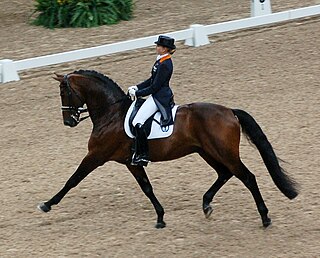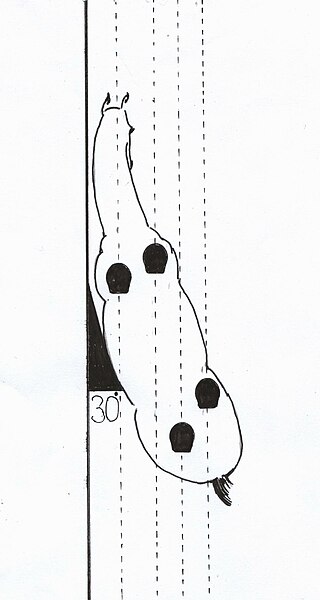
Dressage is a form of horse riding performed in exhibition and competition, as well as an art sometimes pursued solely for the sake of mastery. As an equestrian sport defined by the International Equestrian Federation, dressage is described as "the highest expression of horse training" where "horse and rider are expected to perform from memory a series of predetermined movements.".

Calisthenics or callisthenics (/ˌkælɪsˈθɛnɪks/) is a form of strength training consisting of a variety of movements that exercise large muscle groups, such as standing, grasping, pushing, etc. These exercises are often performed rhythmically and with minimal equipment, as bodyweight exercises.
Because ballet became formalized in France, a significant part of ballet terminology is in the French language.

Classical dressage evolved from cavalry movements and training for the battlefield, and has since developed into the competitive dressage seen today. Classical riding is the art of riding in harmony with, rather than against, the horse.

The canter and gallop are variations on the fastest gait that can be performed by a horse or other equine. The canter is a controlled three-beat gait, while the gallop is a faster, four-beat variation of the same gait. It is a natural gait possessed by all horses, faster than most horses' trot, or ambling gaits. The gallop is the fastest gait of the horse, averaging about 40 to 48 kilometres per hour. The speed of the canter varies between 16 and 27 kilometres per hour depending on the length of the horse's stride. A variation of the canter, seen in western riding, is called a lope, and is generally quite slow, no more than 13–19 kilometres per hour (8–12 mph).

Equine conformation evaluates a horse's bone structure, musculature, and its body proportions in relation to each other. Undesirable conformation can limit the ability to perform a specific task. Although there are several faults with universal disadvantages, a horse's conformation is usually judged by what its intended use may be. Thus "form to function" is one of the first set of traits considered in judging conformation. A horse with poor form for a Grand Prix show jumper could have excellent conformation for a World Champion cutting horse, or to be a champion draft horse. Every horse has good and bad points of its conformation and many horses excel even with conformation faults.

The half-pass is a lateral movement seen in dressage, in which the horse moves forward and sideways at the same time. Unlike the easier leg-yield, the horse is bent in the direction of travel, slightly around the rider's inside leg. The outside hind and forelegs should cross over the inside legs, with the horse's body parallel to the arena wall and his forehand leading. The horse should remain forward, balanced, and bent, moving with cadence. The inside hind leg remains engaged throughout the half-pass, and the horse should not lose its rhythm.

A Pirouette is a French word for the Ballet reference, "to whirl about."

In weight training, a kettlebell is a cast-iron or cast-steel ball with a handle attached to the top. It is used to perform many types of exercises, including ballistic exercises that combine cardiovascular, strength and flexibility training. Kettlebells are the primary equipment used in the weight-lifting sport of kettlebell lifting.
Turn on the forehand is a lateral movement in equestrian schooling that involves moving the horse's hindquarters around his front legs. Although a basic movement, it is an important training tool for both horse and rider.

A "baucher" is also a type of bit, named after the man.

Riding figures are prescribed paths a horse is ridden on in a riding arena, usually for training purposes. Figures may also be performed out in a field or other open area, but a riding arena provides markers that can help indicate the correctness in the size or shape of a figure.

Riding aids are the cues a rider gives to a horse to communicate what they want the animal to do. Riding aids are broken into the natural aids and the artificial aids.
Lateral movements or lateral flexions within equestrianism, have a specific meaning, used to refer to movements made by a horse where the animal is moving in a direction other than straight forward. They are used both in training and in competition, vary in difficulty, and are used in a progressive manner, according to the training and physical limitations of the animal.
The turn of the haunches is a lateral movement performed at the halt and walk, used in horse training. It requires the horse, while bent in the direction of the turn, to move his forehand around his hindquarters so that he makes a very small circle with the inside foreleg. The horse should pivot around a hind-leg, as seen in the spin. Additionally, the horse should continue to display basic requirements of dressage, such as an even and regular rhythm, relaxation, acceptance of the aids, balance, and freedom of movement.

Haunches-in, also called travers or tête au mur, is a lateral movement used in the dressage discipline of horse training. It has a close cousin, haunches-out, renvers, or croupe au mur, that is slightly more difficult. Both movements are four-track, meaning they produce four lines of hoof prints in the sand, as opposed to the usual two seen if the horse is straight and to the three-track shoulder-in.
The shoulder-in is a lateral movement in dressage used to supple and balance the horse and encourage use of its hindquarters. It is performed on three tracks, where the horse is bent around the rider's inside leg so that the horse's inside hind leg and outside foreleg travel on the same line. For some authors it is a "key lesson" of dressage, performed on a daily basis.

Lead refers to which set of legs, left or right, leads or advances forward to a greater extent when a quadruped animal is cantering, galloping, or leaping. The feet on the leading side touch the ground forward of its partner. On the "left lead", the animal's left legs lead. The choice of lead is of special interest in horse riding.
Calf raises are a method of exercising the triceps surae, tibialis posterior, and peroneal muscles of the lower leg. The movement performed is plantar flexion, also called ankle extension.













